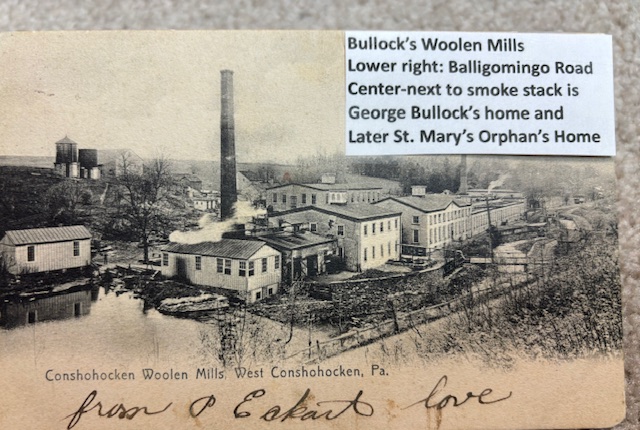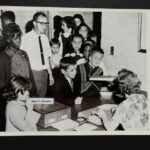
Local Inductees and a Conshohocken Legend PA Sports Hall of Fame
October 1, 2024
Awwww, Conshohocken Italian Bakery to close – We’re Sorry
October 10, 2024West Conshohocken Celebrates Their Sesquicentennial
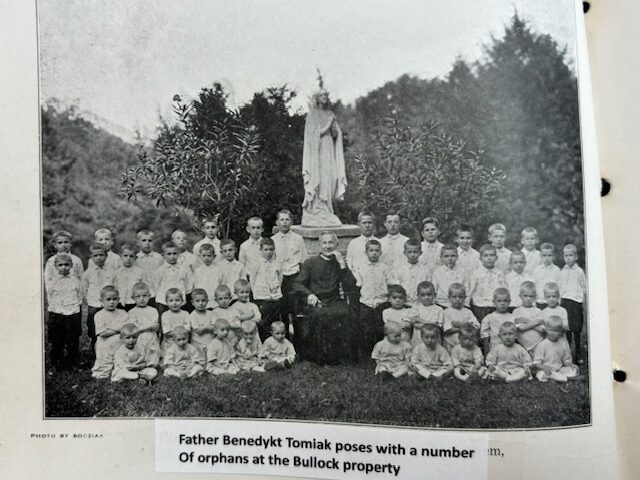
In The Beginning
It was J. B. Moorhead and George D. Bullock
More Than 30 Years after Incorporation,
There Was This Orphanage
West Conshohocken Celebrates Their Sesquicentennial
In The Beginning
It was J. B. Moorhead and George D. Bullock
More Than 30 Years after Incorporation,
There Was This Orphanage
By Jack Coll
10/7/2024
The following article was taken from the book “Tales of Conshohocken & Beyond”
By Jack and Brian Coll
The borough of West Conshohocken incorporated in 1874, has been celebrating their sesquicentennial throughout this past year. To celebrate the mile-stone a banquet will be held on Saturday October 12, 2024 at the Marriott Hotel in West Conshohocken, the event is sold-out.
When I think of the borough of West Conshohocken holding a celebration at a Marriott Hotel, located in West Conshohocken, it makes me laugh a little, to think about how far the borough has come over the past one hundred and fifty years.
There’s an endless book of stories to be told about West Conshohocken from over the years, one of the stories I often think about involves an orphanage, the orphanage was established in Conshohocken, moved to West Conshohocken, to Ambler and wound up in Hollywood.
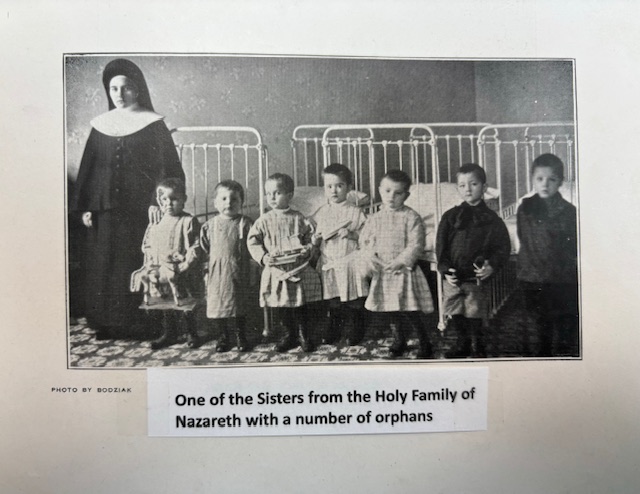
First about the background of the borough and incorporation, then we’ll get to the orphanage. In the fall of 1874, the citizens of the Balligomingo, Matsonford and other small settlements connected in the area filed a court petition for incorporation in Pennsylvania. The newly formed borough was to be known as “West Conshohocken.” The borough contained nearly 300 residents, with two general stores, a railroad depot, a lumber yard, three coal yards, a feed store, two blacksmiths, two wheelwright shops, two furnaces, a small cloth factory, and a few other places of business.
The incorporation petition stated that the settlements of Matson Ford’s and Balligomingo had had a rapid increase in population and projected the settlement would continue to grow. On October 6, 1874, the petition was granted, the documents were signed, and the borough of West Conshohocken was born.
One of the two furnaces operating at the time of incorporation was the Merion Furnace. It was built in 1847 and employed about 30 residents. In 1858, more than 40 houses dotted the landscape known as Matson’s Ford-Balligomingo . By 1870, that number swelled to 96 houses as the J. B. Moorhead Company provided employment for many new residents.
George Bullock was born in 1830 and was dubbed the community’s most important citizen at one time. Bullock was an interesting man who led an interesting life. He and his brother Joseph came from Philadelphia in 1862 to operate a woolen mill formerly owned and operated by Bethel Moore in the village of Balligomingo. Bullock enlarged the mill and made many improvements that gave employment to thousands of workers and residents in the years to come. Bullock’s mill prospered greatly throughout the Civil War as the mill turned out high quality blue woolen cloth for the federal government for army uniforms.
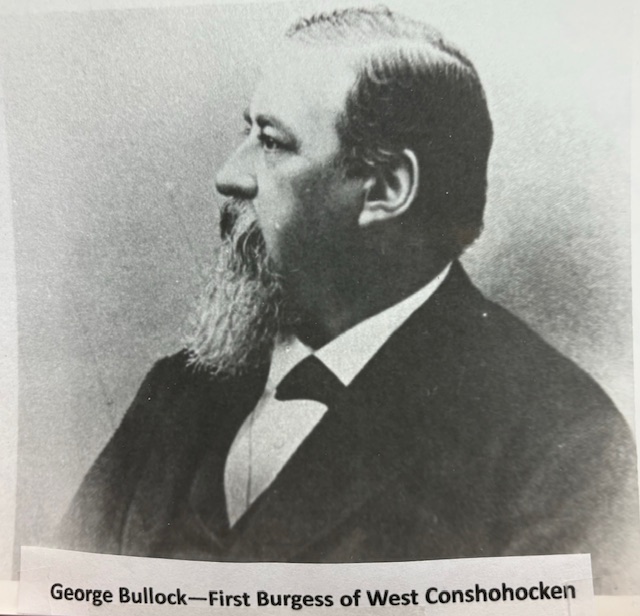
George Bullock married Josephine Wright of Philadelphia. The Bullocks moved to Balligomingo in 1862 and purchased more than 300 acres of land from Bethel Moore’s estate, located around his mill along the Gulph Creek. The Bullocks built their house above the mill and called it “Woodlawn.” (History is not clear if Moore or Bullock built the original mansion, but Bullock made many improvements and added buildings to the property).
Upon incorporation George D. Bullock was elected Burgess of West Conshohocken and served in that capacity for fourteen years, until 1888 when his health started failing him. Bullock also served as President of the First National Bank of Conshohocken for many years. The bank was once located on the corner of Hector and Fayette street. George was also a huge supporter of the Baptist Church of West Conshohocken, (the church was on his property, and he maintained it and never charged the congregation). Bullock reached out to his employees over the years. He erected a building that he called the Mechanics Institute and gave all his employees the opportunity to attend evening educational classes, lectures, a library and what he called high class amusements, Bullock paid all expenses.
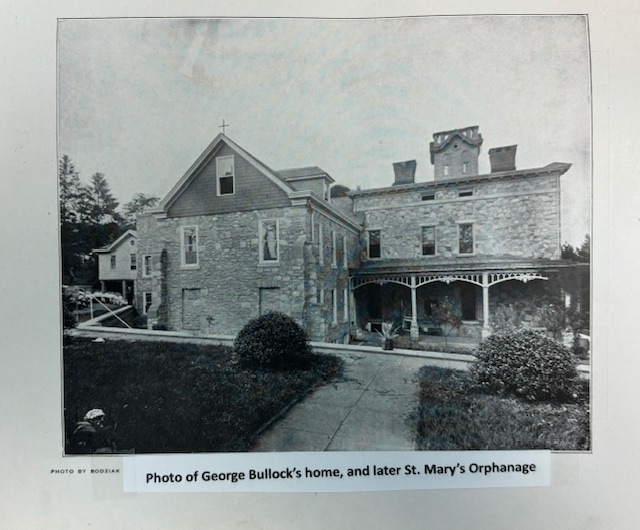
Bullock was instrumental in the borough’s incorporation and provided his building, “The Institute,” as the borough’s very first school house. In 1875 Bullock gave the School Board a site for a modern day schoolhouse and put up the $2,400 to cover construction cost. The four room structure, named after Bullock, was later enlarged, but fire destroyed the building in 1902, despite a valiant effort by members of the George Clay Fire Company to save the building. In 1903, an eight room school house building was erected and served the borough students until the mid-1920’s, when it was condemned by the State Board of Instruction for insufficient light and poor ventilation. The building was later renovated and reopened as an elementary school.
The Bullock School building was later rented to Slavic Candy, which manufactured a variety of candy products. The Bullock building was razed in 1950. The old school bell from Bullock’s School was the only item salvaged and can be seen today at the West Conshohocken Borough Hall on Ford Street.
Until his death on March 8, 1889, George and his wife, Josephine, lived in a large mansion nicknamed “Woodlawn” on the hill behind the mills on Balligomingo road. The mansion sat vacant for a number of years until Anthony Bullock purchased the property. Several years later, Mr. O’Brien purchased the property, and both Bullock and O’Brien stated that the property was very big and a very lonely place to live.

In 1905, Father Benedict Tomiak, helped to establish St. Mary’s Church in Conshohocken. Property was purchased with Father Tomiak personal funds. The property at Oak and Elm Streets was the former home owned by James Wood but at the time of purchase it was owned by William Wood. The house, that would later become the rectory, was the location of St. Mary’s first mass.
As Father Tomiak settled into the new area he thought “Woodlawn” would be a fine place to live. Father Tomiak purchased the mansion and property for $17,000, a modest price for the day, and he moved in. The property was described as a stately mansion with fine conservatories, big stone stables and numerous splendid out buildings, including a stone laundry near the house that was large and fine enough for a private residence. By 1907, Father Tomiak also found the property” too lonely for a home” and offered it for sale at the same price he had purchased it. However, by 1908 he had no takers.
Father Benedict had a soft spot for orphaned children and started an orphanage at St. Mary’s Church in 1906. By 1910, the small orphanage had outgrown the Conshohocken site.
In the spring of 1908, Father Tomiak announced that the former Bullock mansion and remaining 17 acres would make a fine seminary for Polish girls. That plan never materialized, but by 1911, an orphanage for boys called St. Mary’s Orphanage, (later named St. Mary’s Orphans Asylum) opened. The opening of the orphanage came after some extensive renovations and the arrival of the Sisters of the Holy Family of Nazareth from Chicago, Illinois. The sisters were entrusted with the management, guardianship, and education of the orphaned children. The first three orphans, three brothers, arrived from Pittsburgh. Within a short time, orphans from near and far arrived, including children from Wilmington, Chester, Philadelphia, Reading and Swedesburg to name a few places.
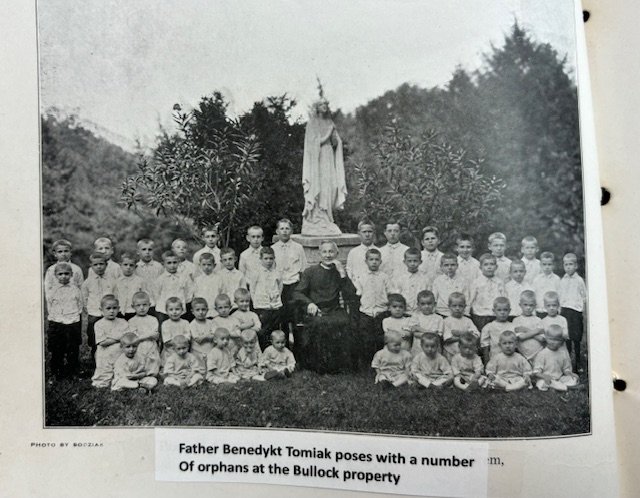
The orphanage was later opened for girls and by the mid 1930’s, had out grown the Bullock estate. On January 1, 1936, the sisters of the Holy Family of Nazareth purchased a mansion in Ambler, a castle-like structure from the estate of Richard Vanselous Mattison for the sum of $115,000. (Mattison was the asbestos king. His asbestos factory in Ambler made him millions) In September of 1936, it became and continued to be a home for children called St. Mary’s Villa for children.
In 1965, Hollywood visited St. Mary’s Villa for children in Ambler to film the backdrop for a movie written by Jane Trahey called, “Life With Mother Superior.” The original title was later changed to “The Trouble With Angels.” The movie starred Rosalind Russell and Hayley Mills. Russell played Mother Superior, while Mills played Mary Clancy, who was sent to an all-girls boarding school.
Children at St. Mary’s Villa at the time enjoyed watching the filming of certain scenes. It was reported that the film called for snow one day and a beautiful spring day the following day. To accomplish this, artificial snow was scattered around the yard before green dye and plastic buds were attached to the leafless trees to transform the grounds overnight into springtime.
I would like to believe, and have Conshohocken and West Conshohocken take a little bit of credit, that a major Hollywood production, filmed in Ambler all those years ago, came about because of Conshohocken and West Conshohocken’s part in forming and maintaining an orphanage in our borough’s. I realize that it’s a bit of a stretch connecting the dots, but who knows, would the movie, “The Trouble with Angels” have ever existed without us, and the use of St. Mary’s Villa.

In recent years St. Mary’s Villa for children was transformed into a senior center now known as St. Mary’s Villa, a senior living and care facility.
When St. Mary’s Orphanage moved to Ambler in 1936, the former Bullock estate/orphanage was converted into an old folks home called St. Joseph’s Rest Home. On a brutally cold January night in 1938, an electrical short at St. Joseph’s sent flames climbing high into the winter sky as 25 residents escaped the fire in night clothes and nothing else. Members of the George Clay and Washington Fire Company’s braved the bitter cold in an attempt to save the structure. The building was saved but badly damaged. In 1940, Joseph and Mary Rogalski, residents of Coates and Holstein Streets in Swedesburg purchased the property with the intention of converting it into apartments. The Rogalskis owned and operated a modern grocery store in Swedesburg but had planned on retiring and operating the apartment house.
The property along Balligomingo Road where the former Bullock estate once stood is now part of an industrial park and landscaping business.
And that folks is just one of the many stories and tales to be told and retold in the annals of West Conshohocken’s 150 years since incorporation. One of the histories blessings is and was the existence of the Conshohocken Recorder newspaper. The Conshohocken Recorder was founded in 1869, and ceased operations in October 2008.
Almost all my research for our borough’s history and stories comes from the Recorder publications. With no more newspapers to tell the stories and daily happenings, I wonder if any of our current history is being recorded. I wonder if 25 or 50 years from now there will be a written history to look back on. I also wonder, with almost all photographs being taken with cell phones, and very few people having photographic prints made from their cell phones, if their will even be a photographic history of families, life-styles, automobile, houses, events and buildings to look back on?
All we can do is enjoy our past history. There’s a new generation out there that’s gonna have to figure out how to tell their history.
Happy Birthday West Conshohocken, I hope to be around long enough to tell more of West Conshohocken’s history and stories, good stories, and sometimes not so good, it’s always interesting!
